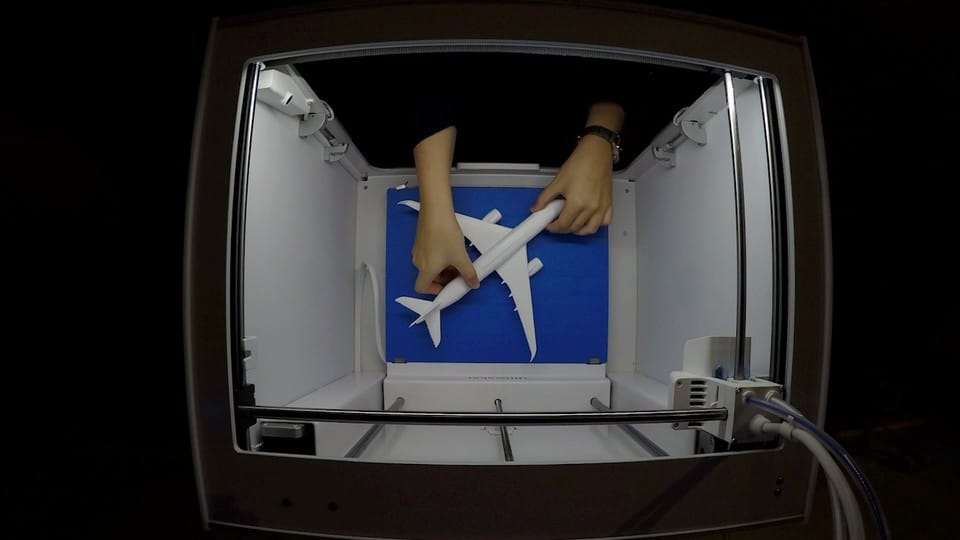Aviation
British Airways is exploring the possibility of using 3D printers to create aircraft parts in the future

- British Airways’ tech experts say the possibilities for 3D printing in aviation are limitless and share predictions of how 3D printers could transform the industry
- In the future machines could routinely be used to create aircraft parts, reducing delays for customers
- Initiative is part of airline’s flightpath to net zero carbon emissions by 2050
British Airways is exploring the possibility of using 3D printers to create aircraft parts in the future. These printers would be located at airports around the world to reduce delays for customers and emissions caused by transporting items.
The airline’s innovators predict that non-essential cabin parts will be first on the list to be generated, including pieces of tray tables, entertainment systems and toilets. While these components do not impact the safe operation of the flight, they can reduce the number of seats or toilets available for customers and cause delays as engineers wait for the parts to be flown to wherever the aircraft is.
Ricardo Vidal, Head of Innovation at British Airways, says this area of technology has never been more important to ensure sustainability and a seamless travel experience: “We work with start-ups and innovation partners from around the world to explore and implement the very latest technologies, from artificial intelligence to speed up turnaround times to biometrics, helping us to deliver a seamless airport experience for customers. 3D printing is yet another advancement that will keep us at the forefront of airline innovation.”
3D printing is an essential step towards the sustainable future of aviation, as the printers can produce parts that, while as strong and durable as traditional components, weigh up to 55 per cent. Every kilogram removed saves up to 25 tons of CO2 emissions during the lifespan of an aircraft.
Watch a time-lapse of a model of the airline’s A350 being printed
British Airways’ exploration of 3D printing follows the airline’s BA2119: Flight of the Future programme in celebration of it’s centenary. It’s research into the future of the customer experience suggested that within the next decade, biological scanners gathering travellers’ physiological and nutritional needs could suggest food and drink to meet individual requirements and print these on board the aircraft. In addition, the research predicts that jet lag could become be a thing of the past, with 3D printers producing personalised health supplements.
British Airways’ top ten predictions for how 3D printing could be used by airline’s in the future:
1. Cutlery
2. Products for amenity kits, such as toothbrushes or combs
3. Tray tables
4. Aircraft windows
5. Inflight entertainment screens
6. Seats
7. Baggage containers
8. Circuit boards for electrical components
9. Flight deck switches
10. Aircraft shells

Aviation
Boeing, Antonov to Collaborate on Defense Projects

– MOU represents Boeing’s commitment to work with Ukrainian industry
– Includes exploring opportunities for collaborating on in-country support of Unmanned Aerial Systems
A Memorandum of Understanding was signed today by Boeing and Antonov Company to investigate potential collaboration on defense-related projects.
“We’re happy to keep collaborating with the Antonov Company to help Ukraine’s economic development and expansion,” stated Ted Colbert, CEO and president of Boeing Defence, Space, & Security.
Airbus and the Antonov An-225: The Best Partnership:Click here
“This agreement demonstrates our ongoing efforts to find more opportunities to work with Ukrainian industry, which was underscored by our signing of the Ukrainian Defence Industry Compact earlier this year.”
The areas of potential collaboration identified in the agreement consist of training, logistical support and overhaul services for tactical Unmanned Aerial Systems utilized by the Ukrainian Armed Forces, which includes the ScanEagle. In addition, the companies will also explore opportunities for Antonov to provide engineering support to Boeing.
The six largest cargo aircraft ever built in the aviation industry:Click here
“A strong, innovative, and efficient defense industry is key to sustainable economic development and national security, and we are extremely excited to collaborate with Boeing,” said Ievhen Gavrylov, CEO of Antonov Company.
This agreement brings a whole new level of opportunity to implement the latest and most effective solutions – in addition to the possibility of future projects with Boeing in the aerospace and defense industry.”
-

 Travel1 week ago
Travel1 week agoAir India to Expand US Operations with Three New Routes After a Decade
-

 Travel2 weeks ago
Travel2 weeks agoWhy We Should Avoid These Stamps in a Passport
-

 Airlines1 month ago
Airlines1 month agoInvestigations Reveal Fake Chinese Titanium in Boeing and Airbus Jets
-

 Tech4 weeks ago
Tech4 weeks agoChina’s CATL Plans 1,800-Mile Electric Plane Launch by 2027
-

 Airport3 days ago
Airport3 days agoTop 10 Largest Airports in the World by Size
-

 Aerospace4 weeks ago
Aerospace4 weeks agoChina’s Fighter Jets Turn Wings into Autonomous Drones
-

 Airlines4 days ago
Airlines4 days agoAir India Rolls Out A350s for Delhi-New York JFK and Newark Routes
-

 Defence3 weeks ago
Defence3 weeks agoBoeing Enhances Chinook with New Engines and Block II Upgrades at $96 Million







